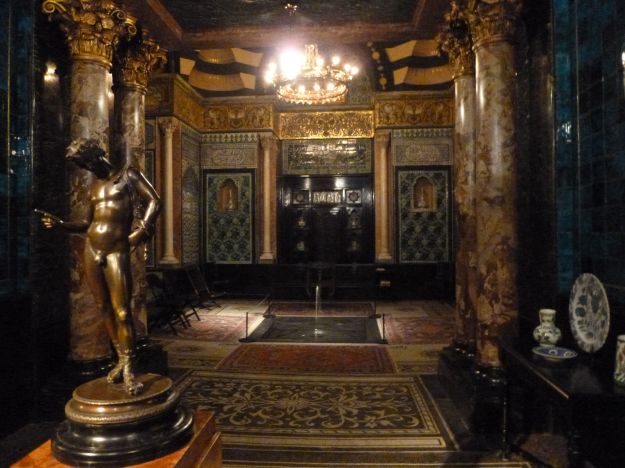An oriental crescent moon was shining as I arrived at Leighton House and entered its bejewelled Arab Hall. Ever since this One Thousand and One Nights fantasy was unveiled in 1879 by its artist/owner, Lord Leighton, it has dazzled visitors with its panels of Islamic tiles, golden dome and mosaic floors. Queen Victoria was one of many who have come to marvel at what he built “for the sake of something beautiful to look at once in a while”—and to showcase paintings that included his own, executed in his upstairs studio.
But not since Leighton died in 1896 and his collection was dispersed has there been a better time to soak up its atmosphere. Its silk-clad walls are currently hung with 52 rarely seen paintings owned by Mexico’s Pérez Simón, the largest collection of Victorian art outside Britain. These include four works by Lord Leighton that have returned for the first time since he painted them here.

Back after a long absence: Greek Girls picking up Pebbles by the Sea painted by Lord Leighton in his vast studio upstairs.
Roaming around these sensual rooms I felt as if I were being drawn into a dream. A fountain lazily trickled and Moorish lanterns illuminated lustrous friezes of fantasy creatures and calligraphy. Many of the paintings feature women draped in flimsy robes and I could imagine them descending from the walls to perform the dance of the seven veils.

A cruel Roman emperor drowns his dinner guests in petals: The Roses of Heliogabalus by Lawrence Alma-Tadema.
Adding to the mystique was the heady scent of roses that billows from the room with the stand-out painting: The Roses of Heliogabalus by Lawrence Alma-Tadema. This unsettling depiction of the depraved eponymous Roman emperor drowning his dinner guests in a sea of sumptuous petals is particularly strange for the lack of expression on the guests’ faces: neither horror nor blind pleasure as they suffocate in this exquisitely rendered onslaught.
Indeed many of the works feature wistful subjects gazing as if in a reverie. Don’t come here for psychological insight: this show is about entering a magic kingdom of myth and romance. I drifted through rooms with paintings such as Alma-Tadema’s woman on a Neapolitan terrace: Her Eyes are with her Thoughts and they are Far Away, Henry Arthur Payne’s princess sailing on a shell: The Enchanted Sea, and John William Waterhouse’s woman gazing into her future: The Crystal Ball.
I looked at works by painters who often visited Leighton in his house—Dante Gabriel Rossetti, Edward Burne-Jones and John Everett Millais—and imagined the artists sprawling on the ottoman divans.
A Victorian Obsession: The Pérez Simón Collection at Leighton House Museum, near Holland Park, London, continues until 29 March 2015. It is both a chance to view art and a piece of “immersive theatre”, where the setting is part of the show.
My tip for maximum atmosphere is to attend one of the many upcoming evening events. There are regular late night openings and curator tours plus debates, music, poetry, film and theatre evenings. I especially like the idea of the Aesthetic Soirée on 25 February. I’m only sorry that Lord Leighton, known for his “princely manner”, won’t be there to act as host.


